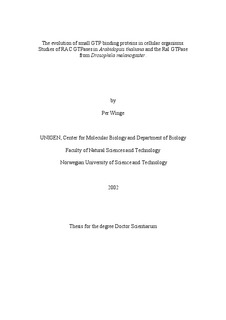| dc.description.abstract | Small GTP binding proteins function as molecular switches which cycles between GTP-bound ON and GDP-bound OFF states, and regulate a wide variety of cellular processes as biological timers. The first characterized member of the small GTPase family, the mutated oncogene p21 src, later known as Harvey-Ras, was identified in the early 1980s (Shih, T. Y. et al. 1980). In the following years small Ras-lik GTPases were found in several organisms and it was soon discovered that they took part in processes, such as signal transduction, gene expression, cytoskeleton reorganisation, microtubule organisation, and vesicular and nuclear transport. The first Rho (Ras homology) gene was cloned in 1985 from the sea slug Aplysia (Madaule, P. et al. 1985) and because of their homology to Ras it was first suspected that they could act as oncogenes. Later studies have shown that even though they participate in processes such as cell migration and motility they are not mutated in cancers.
The first indications that Rho was a signaling protein regulating the actin cytoskeleton, came from experiments where activated forms of human RhoA was microinjected into 3T3 cells (Paterson, H. F. et al. 1990). Another Rho-like GTPase Rac1 (named after Ras-related C3 botulinum toxin substrate) was later shown to regulate actin cytoskeletal dynamics as well, suggesting that Rho-family members cooperate in controlling these processes (Ridley, A. J. et al. 1992). The Rac GTPase was also implicated in regulating the phagocytic NADPH oxidase, which produce superoxide for killing phagocytized microorganisms (Abo, A. et al. 1991). Thus, it soon became clear that Rac/Rho and the related GTPase Cdc42 (cell division cycle 42) had central functions in many important cellular processes.
There are at least three types of regulators for Rho-like proteins. The GDP/GTP exchange factors (GEFs) which stimulates conversion from the GDPbound form to the GTP-bound form. GDP dissociation inhibitors (GDIs) decrease the nucleotide dissociation from the GTPase and retrieve them from membranes to the cytosol. GTPase activating proteins (GAPs) stimulates the intrinsic GTPase activity and GTP hydrolysis. In addition there are probably regulators that dissociate GDI from the GTPase leaving it open for activation by the RhoGEFs.
Ras and Rho-family proteins participate in a coordinated regulation of cellular processes such as cell motility, cell growth and division. The Ral GTPase is closely related to Ras and recent studies have shown that this GTPase is involved in crosstalk between both Ras and Rho proteins (Feig, L. A. et al. 1996; Oshiro, T. et al. 2002). Ral proteins are not found in plants and they appear to be restricted to animalia and probably yeast. During a screen for small GTPases in Drosophila melanogaster I discovered in 1993 several new members of the Ras-family, such as Drosophila Ral (DRal), Ric1 and Rap2. The functions of Ral GTPases in Drosophila have until recently been poorly known, but in paper 2 we present some of the new findings.
Rho-like GTPases have been identified in several eukaryotic organisms such as, yeast (Bender, A. et al. 1989), Dictyostelium discoideum (Bush, J. et al. 1993), plants (Yang, Z. et al. 1993), Entamoeba histolytica (Lohia, A. et al. 1993) and Trypanosoma cruzi (Nepomuceno-Silva, J. L. et al. 2001). In our first publication, (Winge, P. et al. 1997), we describe the cloning of cDNAs from RAC-like GTPases in Arabidopsis thaliana and show mRNA expressions pattern for five of the genes. The five genes analyzed were expressed in most plant tissues with the exception of AtRAC2 (named Arac2 in the paper), which has an expression restricted to vascular tissues. We also discuss the evolution and development of RAC genes in plants. The third publication, (Winge, P. et al. 2000), describe the genetic structure and the genomic sequence of 11 RAC genes from Arabidopsis thaliana. As most genomic sequences of the AtRACs we analyzed came from the Landsberg erecta ecotype and the Arabidopsis thaliana genome was sequenced from the Columbia ecotype, it was possible to compare the sequences and identify new polymorphisms. The genomic location of the AtRAC genes plus the revelation of large genomic duplications provided additional information regarding the evolution of the gene family in plants. A summary and discussion of these new findings are presented together with a general study of small Ras-like GTPases and their evolution in cellular organisms. This study suggests that the small GTPases in eukaryots evolved from two bacterial ancestors, a Rab-like and a MglA/Arp-like (Arf-like) protein. The MglA proteins (after the mgl locus in Myxococcus xanthus) are required for gliding motility, which is a type of movement that take place without help of flagella.
The second publication describes experiments done with the Drosophila melanogaster DRal gene and its effects on cell shape and development. Ectopic expression of dominant negative forms of DRal reveals developmental defects in eye facets and hairs, while constitutive activated forms affects dorsal closure, leaving embryos with an open dorsal phenotype. Results presented in this publication suggest that DRal act through the Jun N-terminal kinase (JNK) pathway to regulate dorsal closure, but recent findings may point to additional explanations as well. The results also indicate a close association between processes regulated by Rac/Rho and Ral proteins in Drosophila. | nb_NO |
| dc.relation.haspart | Sawamoto, K; Winge, P; Koyama, S; Hirota, Y; Yamada, C; Miyano, S; Yoshikawa, S; Jin, MH; Kikuchi, A; Okano, H. The Drosophila Ral GTPase regulates developmental cell shape changes through the Jun NH2-terminal kinase pathway. Journal of Cell Biology. 146(2): 361-372, 1999. | nb_NO |
